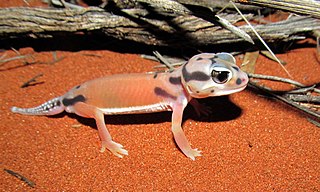
The genus Nephrurus, collectively referred to as the knob-tailed geckos, comprises several species of small, desert-dwelling, drought-tolerant Australian gecko. They are named for their stubby, knob-like tails, and are also easily identified by their rather large eyes. This adaptation of enlarged eyes is indicative of an animal’s lifestyle being predominantly crepuscular or nocturnal.

Underwoodisaurus is a small genus of Australian lizards in the family Carphodactylidae. Member species are commonly known as thick-tailed geckos, along with the species Uvidicolus sphyrurus.

Nephrurus deleani, also known commonly as the acacia knob-tailed gecko, the Pernatty knob-tail, and the Pernatty knob-tailed gecko, is a species of lizard in the family Carphodactylidae. The species is endemic to Australia.
Uvidicolus is a monotypic genus of lizard in the family Carphodactylidae. The genus contains the sole species Uvidicolus sphyrurus, also known commonly as the border thick-tailed gecko. The species is endemic to Australia.

Nephrurus amyae, also known commonly as the Centralian rough knob-tail gecko or the Centralian rough knob-tailed gecko, is a species of lizard in the family Carphodactylidae. It is the largest gecko in the genus Nephrurus, and like all species of Nephrurus is endemic to Australia.

Heteronotia binoei, also known commonly as the Bynoe's gecko, is a species of lizard in the family Gekkonidae. The species is endemic to Australia. One of Australia's least habitat-specific geckos, it occurs naturally across much of the country, and has also established in areas where it does not occur naturally, such as urban Perth, Western Australia. It is dark brown to reddish brown, depending on the colour of the ground upon which it lives. There are irregular light bands with dark edges along its back.
Nephrurus stellatus, also known as the stellate knob-tailed gecko, starry knob-tailed gecko, or southern knob-tailed gecko, is a species of gecko in the family Carphodactylidae. It is endemic to southern Australia.

The Carphodactylidae, informally known as the southern padless geckos, are a family of geckos, lizards in the infraorder Gekkota. The family consists of 32 described species in 7 genera, all of which are endemic to Australia. They belong to the superfamily Pygopodoidea, an ancient group of east Gondwanan geckos now only found in Australasia. Despite their well-developed limbs, molecular phylogenies have demonstrated that Carphodactylidae is the sister group to Pygopodidae, a highly specialized family of legless lizards.
Lucasium byrnei, also known commonly as the gibber gecko, Byrne's gecko, and the pink-blotched gecko, is a species of small, nocturnal lizard in the family Diplodactylidae. The species is endemic to Australia.

Nephrurus levis, commonly known as the three-lined knob-tailed gecko, smooth knob-tailed gecko, or common knob-tailed gecko, is a native Australian gecko species. The smooth knob-tailed gecko is part of the Carphodactylidae family, a family endemic to Australia. A common, alternative, name for this family is barking geckos due loud barks they make during threat displays, which includes swaying their bodies, winding their tail and attacking with an open mouth. There are multiple sub-species of Nephrurus levis, these include N.l. levis, N.l. occidentalis and N.l. pibarenis. Its aboriginal name is Illchiljera.
The smooth knob-tailed gecko is a type of gecko and may refer to:

Nephrurus laevissimus, also known as the smooth knob-tailed gecko , is a species of gecko. Like all species of Nephrurus, it is endemic to Australia.
Nephrurus sheai, also known commonly as the Kimberley rough knob-tailed gecko and the northern knob-tailed gecko, is a species of lizard in the family Carphodactylidae. The species is endemic to Australia.
Nephrurus vertebralis, also known as midline knob-tailed gecko, is a species of gecko. Like all species of Nephrurus is endemic to Australia.
Nephrurus wheeleri, also known commonly as the banded knob-tailed gecko, the southern banded knob-tailed gecko, and Wheeler's knob-tailed gecko, is a species of lizard in the family Carphodactylidae. The species, like all species of Nephrurus, is endemic to Australia.

Phyllurus amnicola, also known as the Mount Elliot leaf-tailed gecko or the Riverine leaf-tailed gecko, is a species of gecko found in Australia. It is endemic to Mount Elliot in Bowling Green Bay National Park in northeastern Queensland.

Pygopodoidea is a gecko superfamily and the only taxon in the gekkotan subclade Pygopodomorpha. The clade includes three Australasian families: Diplodactylidae, Carphodactylidae, and Pygopodidae. Traditional gekkotan systematics had considered Diplodactylidae and Carphodactylidae as subfamilies of the family Gekkonidae, but recent molecular work have placed Pygopodidae within Gekkonidae making it paraphyletic. These analyses have shown support of Pygopodidae and Carphodactylidae being sister taxa, with Diplodactylidae occupying a basal position in Pygopodoidea.
Nephrurus cinctus, also known as northern banded knob-tailed gecko, is a species of gecko. Like all species of Nephrurus is endemic to Australia.

Gawler is an interim Australian bioregion located in South Australia. It has an area of 12,002,883 hectares. Gawler bioregion is part of the Tirari–Sturt stony desert ecoregion.










